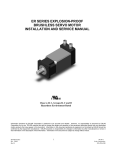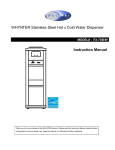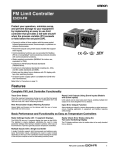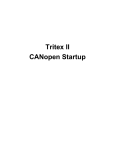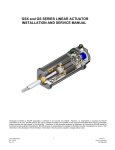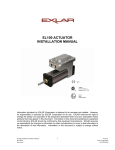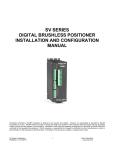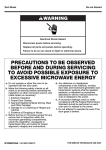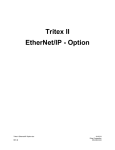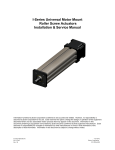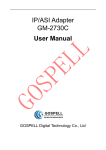Download EL series Installation & User Manual
Transcript
EL30 EXPLOSION-PROOF LINEAR ACTUATOR INSTALLATION AND SERVICE MANUAL Class I, div 1, Groups B, C and D Hazardous Environment Rating Information furnished by EXLAR Corporation is believed to be accurate and reliable. However, no responsibility is assumed by EXLAR Corporation for its use. EXLAR reserves the right to change the design and operation of the equipment described herein and any associated motion products that may appear in this document. Information in this document pertaining to equipment not furnished by EXLAR should be confirmed by that equipment manufacturer. EXLAR assumes no responsibility for changes to information by other manufacturers or errors in that information or the description of that information. Information in this document is subject to change without notice. 1 EL Series Explosion-Proof Actuator Manual PN: 23942 Rev D 6/14/2011 Exlar Corporation 952-500-6200 TABLE OF CONTENTS 1.0 Introduction 1.1 Warranty and Limitations of Liability 1.2 Safety Considerations 1.3 Explosion-Proof Ratings 2.0 System Configuration 2.1 Typical System Configuration 2.2 Typical System Wiring 2.3 Standard Actuator Pin-outs and Connections 2.4 Feedback Information 3.0 Installation and Operation 3.1 Lubrication Requirements 3.2 Grease Lubrication 3.5 Mounting Configurations 3.6 Mounting Considerations 3.7 General Operation 4.0 Maintenance Procedures 4.1 Disassembly 4.2 Lubrication Maintenance 4.3 Reassembly 4.4 Seal Maintenance 5.0 Specifications 5.1 EL Series Performance Specifications 5.2 EL Series Mechanical and Electrical Specifications 6.0 Troubleshooting Procedures 7.0 Installation 7.1 Exlar SV Series with EL30 Linear Actuator 2 EL Series Explosion-Proof Actuator Manual PN: 23942 Rev D 6/14/2011 Exlar Corporation 952-500-6200 1.0 INTRODUCTION 1.1 Warranty and Limitation of Liability EXLAR warrants its product(s) to the original purchaser and in the case of original equipment manufacturers, to their original customer to be free from defect in material and workmanship and to be made in accordance with Exlar’s specifications for the product(s) as published at the time of purchase unless otherwise agreed to in writing by an authorized Exlar representative. In no event shall EXLAR be liable or have any responsibility under such warranty if the products have been improperly stored, installed, used or maintained, or if Buyer has permitted any unauthorized modifications, adjustments and/or repairs to such product(s). Seller's obligation hereunder is limited solely to repairing or replacing (at its option), at the factory, any product(s), or parts thereof, which prove to Seller's satisfaction to be defective materials or workmanship, and within the period of time in accordance with the seller's stated product warranty (see terms and conditions), however, that written notice of claimed defects shall have been given to EXLAR within 30 days from the date any such defect is first discovered. The product(s) or part(s) claimed to be defective must be returned to EXLAR, transportation prepaid by Buyer, with written specification of the claimed defect. Components such as seals, wipers, bearings, bushings, splines and roller screw components are considered wear parts and must be inspected and serviced on a regular basis. Any damage caused by failure to properly lubricate EXLAR products and/or to replace wear parts at appropriate times is not covered by this warranty. THE FOREGOING WARRANTY IS IN LIEU OF ALL OTHER WARRANTIES (EXCEPT AS TITLE), WHETHER EXPRESSED OR IMPLIED, INCLUDING WITHOUT LIMITATION, ANY WARRANTY OF MERCHANTABILITY, OR OF FITNESS FOR ANY PARTICULAR PURPOSE, OTHER THAN AS EXPRESSLY SET FORTH AND TO THE EXTENT SPECIFIED HEREIN, AND IS IN LIEU OF ALL OTHER OBLIGATIONS OR LIABILITIES ON THE PART OF EXLAR. SELLER'S MAXIMUM LIABILITY WITH RESPECT TO THESE TERMS AND CONDITIONS AND ANY RESULTING SALE, ARISING FROM ANY CAUSE WHATSOEVER, INCLUDING WITHOUT LIMITATION, BREACH OF CONTRACT OR NEGLIGENCE, SHALL NOT EXCEED THE PRICE SPECIFIED HEREIN OF THE PRODUCT(S), GIVING RISE TO THE CLAIM, AND IN NO EVENT SHALL EXLAR BE LIABLE UNDER THE TERMS OF THE WARRANTY OTHERWISE FOR SPECIAL, INCIDENTAL OR CONSEQUENTIAL LOSSES RESULTING FROM INABILITY TO USE THE PRODUCT(S), INCREASED OPERATING COST, LOSS OF PRODUCTION, LOSS OF SPECIAL INCIDENTAL OR CONSEQUENTIAL DAMAGES, WHETHER SIMILAR OR DISSIMILAR OF ANY NATURE ARISING OR RESULTING FROM THE PURCHASE, INSTALLATION, REMOVAL, REPAIR, OPERATION, USE OR BREAKDOWN OF THE PRODUCT(S), OR ANY OTHER CAUSE WHATSOEVER INCLUDING NEGLIGENCE. The foregoing warranty shall apply to products or parts that have been repaired or replaced pursuant to such warranty, and within the period of time, in accordance with the Seller's stated warranty. No person including any agent of EXLAR, is authorized to make any representation of warranty on behalf of EXLAR concerning any products manufactured by EXLAR, except to refer to this warranty. 3 EL Series Explosion-Proof Actuator Manual PN: 23942 Rev D 6/14/2011 Exlar Corporation 952-500-6200 1.2 Safety Considerations As with any electro-mechanical device, safety should be considered during the installation and operation of your EL Series actuator. Throughout this manual you will see paragraphs marked with CAUTION and WARNING signs as shown below. CAUTION WARNING Pay particular attention to these paragraphs. They are intended to provide you with helpful information to ensure safe and trouble-free installation. 1.3 Explosion-Proof Ratings EL Series actuators are rated for Class 1, div 1, Groups B, C and D. The classification of "Class 1" means that flammable gases or vapors may be present in the air in quantities sufficient to produce explosive or ignitable mixtures. "Division 1" means that hazardous concentrations in the air may exist continuously, intermittently, or periodically under normal operating conditions. "Group B" allows for atmospheres containing hydrogen, or gases (or vapors) of equivalent hazard, such as manufactured gas. "Group C" allows for atmospheres containing ethyl-ether vapors, ethylene or cyclo propane. "Group D" allows for atmospheres containing gasoline, hexane, naptha, benzene, butane, alcohol, acetone, benzol, lacquer solvent vapors, or natural gas. EL Series actuators are not rated for operation in atmospheres containing acetylene. It is the responsibility of the user to provide for properly rated conduit connections to the EL Series actuator. Exlar takes no system responsibility beyond the actuator ratings. 4 EL Series Explosion-Proof Actuator Manual PN: 23942 Rev D 6/14/2011 Exlar Corporation 952-500-6200 2.0 SYSTEM CONFIGURATION 2.1 EL Series Actuator System Configuration EL Series actuators incorporate an integral brushless servo motor. The design of this motor and selection of the proper feedback configuration allows EL Series actuators to be powered by nearly every brand of brushless motor amplifier on the market that powers brushless motors with resolver feedback. The schematic below shows the typical connections for a single axis system with an EL actuator and servo amplifier. Each brand of brushless motor amplifiers may have unique wiring requirements, parameter settings and operational principles that affect how the actuator operates. Details on connections can be obtained from Exlar applications engineering. Never attempt to connect or disconnect the actuator with power applied. Dangerous voltages are present. Damage to equipment and injury to personnel can result. Many amplifiers have voltage present for a considerable time period after incoming power is removed. Take care to insure that the amplifier has discharged all power. 5 EL Series Explosion-Proof Actuator Manual PN: 23942 Rev D 6/14/2011 Exlar Corporation 952-500-6200 Typical System Connections 6 EL Series Explosion-Proof Actuator Manual PN: 23942 Rev D 6/14/2011 Exlar Corporation 952-500-6200 2.2 Typical System Wiring Please refer to Section 7.0 for specific wiring information. 2.3 Standard Actuator Connections Please refer to Section 7.0 for connection information. 2.4 Feedback Information EL Series actuators use resolvers as their primary feedback device. Depending on the amplifier that will e used to operate the actuator, the hookup of the actuator can vary. Always consult Section 7.0 for proper wiring, or contact Exlar for the correct wiring details. The EL Series actuators incorporate a 2 pole resolver as the primary rotary feedback device. The selection of this feedback device is dictated by the amplifier that the end user will use to operate the actuator. This amplifier is indicated in the model number of the EL Series actuator as a 3 digit code consisting of 2 letters and 1 number. Each amplifier has specific requirements for the feedback on the motor. Not all resolver-based amplifiers can use the same resolver, resolver alignment, or relative direction of resolver rotation. Many amplifiers offer software that allows the entering of parameters or the downloading of "motor data files" that dictate how the feedback must be set up on the motor. Exlar can provide many of these "data files" or the proper parameters to enter. Entering motor parameter data to some amplifiers may require assistance from the amplifier manufacturer. Feedback Alignment When Exlar manufactures an EL Series actuator, the feedback is mounted, aligned and test run on the amplifier that the customer plans to use, or one that is known to be equivalent for confirming proper feedback alignment and operation. In any case where it is determined that the feedback has become mis-aligned, or an amplifier change is made requiring the feedback to be aligned differently, it is recommended that Exlar be contacted and arrangements made to have that procedure performed. Feedback Wiring The wiring of the feedback device is critical to the operation of the actuator with the selected amplifier. Miswiring the feedback cable can cause unstable operation, incorrect operation or no operation at all. In some cases, if the proper current limits are not set in the amplifier, mis-wiring of the feedback cable can lead to damage of the motor. Resolvers A resolver is a non-electronic device that works like a small transformer. When rotated, it generates two sine waves that are out of phase with one another. By decoding these two sine waves, the amplifier can monitor the direction, revolutions traveled and speed of rotation of the motor. Each sine wave typically represents one revolution of the motor, so the amplifier can also use these signals to know where the motor is within that revolution. By knowing the motor's position, the amplifier can properly time the supply of current and voltage to the motor for it to rotate. This process is commutation. For the amplifier to properly commutate the motor, it must have a reference, or zero, point from which to track the motor's rotation. This reference point is critical, and is provided to the amplifier through the proper alignment of the resolver to the phases of the motor during the actuator assembly. 7 EL Series Explosion-Proof Actuator Manual PN: 23942 Rev D 6/14/2011 Exlar Corporation 952-500-6200 3.0 INSTALLATION AND OPERATION 3.1 Lubrication Requirements The actuator is shipped from the factory fully greased and ready for installation. Exlar recommends using Mobilith SHC 220, a high performance, extreme-pressure grease. The unique physical properties of the synthetic base oil provide outstanding protection against wear, rust, corrosion and high or low-temperature degradation. Mobilith SHC allows for very low starting and running torque values. Its operating range is minus 40 degrees C to plus 177 degrees C (-40 degrees F to +350 degrees F). 3.2 Mounting Configurations The EL Series actuators come with a choice of mounting configurations. The standard configurations available are Rear Clevis, Front Flange or Threaded Face. Certified drawings are available from Exlar. General drawings are shown in the Exlar catalog. 3.3 Mounting Considerations As with any linear actuator product, misalignment of the EL Series actuator with respect to whatever load the actuator is being used to move is of great concern. Any misalignment will decrease the life of the components within the actuator and also may create problems within the application associated with misalignment. Therefore every effort should be made to minimize misalignment as much as is possible. Excessive side load on the output rod of the actuator will dramatically reduce the life of the actuator and should be avoided completely. Side load can be caused from misalignment or loading that is not inline with the actuator output rod. 3.4 General Operation The EL Series linear actuators function in the same manner as a brushless servomotor. The servo amplifier is used to rotate the motor at controlled speed and torque, and for controlled numbers of revolutions and move times. This rotary motion is translated into linear motion by the internal planetary roller screw mechanism of the EL Series linear actuator. The relationship between the rotary motion of the motor and the linear motion of the actuator corresponds to the following relationships: Linear Distance Traveled (in) = (Motor Revolutions)*(Roller Screw Lead) Linear Speed (in/sec) = ((Motor RPM) / 60)*(Roller Screw Lead) Linear Force (lbf) = ((Motor Torque (in-lbf))*(2π)*(efficiency)) / (Roller Screw Lead (in)) All of the above relationships require proper anti-rotation of the EL Series actuator rod. 8 EL Series Explosion-Proof Actuator Manual PN: 23942 Rev D 6/14/2011 Exlar Corporation 952-500-6200 For more information on sizing and selection of EL Series actuators and servo amplifiers to power them, consult the sizing and selection section of the Exlar catalog. Motor RMS current must be maintained at a level below the continuous current rating of the EL Series actuator or damage to the motor stator will result. The peak current setting must be maintained at a level below the peak current rating of the EL Series actuator or damage to the stator will result. Care should be taken not to exceed the physical travel limits of EL Series Actuators. Doing so will cause the actuator to end-crash internally. End crashes can physically damage the roller screw and the internal components of the actuator. 9 EL Series Explosion-Proof Actuator Manual PN: 23942 Rev D 6/14/2011 Exlar Corporation 952-500-6200 4.0 MAINTENANCE PROCEDURES 4.1 Disassembly Refer to the exploded view on the following page. 1.) Remove the actuator assembly from the machine by disconnecting the cables, main rod coupling and actuator mounting bolts or fasteners. 2.) If your unit does not have an external anti rotate assembly, skip this step. Loosen the two machine screws that clamp the anti-rotate cross member to the actuator output rod. Slide the anti-rotate mechanism forward and off the actuator. 3.) Remove the rear tie rod nuts from the back of the actuator. Extreme care should be taken when removing the tie rod nuts or tie rods so as not to twist or pull on the end cap of the actuator. The end cap houses the feedback device. Alignment of this feedback device to the phases of the motor is critical to the operation of the system. Some feedback devices are sensitive to movement of their mounting surface once installed and can be damaged if care is not taken. 4.) If your actuator does not have a front flange, skip this step. Slide the front flange forward and off the actuator. The tie rods will remain attached to the front flange. 4.2 Lubrication Maintenance Grease lubricated units will require periodic inspection and renewal of the bearing and roller screw grease. The table below shows the recommended grease renewal period. RMS Rotational speed(RPM) 250 500 1000 1500+ Recommended Grease Renewal Period hours) CASE TEMP 65ºC (149ºF) 10,000 8,500 6,000 3,500 CASE TEMP 80ºC (176ºF) 5,000 4,250 3,000 1,750 CASE TEMP 95ºC (203ºF) 2,500 2,125 1,500 875 Grease Renewal The angular contact thrust bearings located in the front of the actuator, the roller screw cylinder, and the roller screw assembly are the components that require grease. They require a coating of grease. They do not need to be packed with grease. Excess grease only requires more torque from the motor when returned to operation, and does not improve the lubrication of the unit. 1.) Use a brush to work approximately 0.5 in3 of grease for every 3 inches of stroke length into the roller screw cylinder. Be sure to cover all of the threaded areas of the cylinder. 10 EL Series Explosion-Proof Actuator Manual PN: 23942 Rev D 6/14/2011 Exlar Corporation 952-500-6200 2.) Use a brush to work grease in to the roller screw assembly. Be sure to cover all the threaded surfaces of the screw assembly. This can be accomplished by applying grease to a few places on the roller screw assembly and rotating the components repeatedly in both directions to work the grease into the assembly. 3.) Force grease into the front of the thrust bearing assembly. Make a concerted effort to insure that the grease is well worked in. Grease must reach the bearing just behind the bearing that is visible as well. Use the following amounts of grease for each size roller screw and bearing: EL30: 0.75 in3 4.3 Reassembly 1.) Rethread the roller screw into the internally threaded cylinder (ITC). It is a multiple start screw, and this is not always easy. DO NOT FORCE THE ROLLER SCREW INTO THE CYLINDER. It is best to have the actuator vertical with the open end of the roller screw cylinder facing up. Position the roller screw above the cylinder so that it is aligned axially with the ITC. Slowly turn the roller screw 1/4 to 1/2 a turn counterclockwise with it in contact with the ITC. This will help to align the threads on the roller screw with the threads in the ITC. Rotate the roller screw clockwise and it should begin to thread into the cylinder. If it does not turn freely, remove it and begin again. When threading the screw into the cylinder, it will roll freely into the actuator. When it reaches the portion of the cylinder that contains the motor magnets, the roller screw will be more difficult to turn because of the magnetic field of the magnets. THIS IS NORMAL. Continue to thread the roller screw into the cylinder. When it reaches the bottom, it will become difficult to turn and the motor and bearings will begin to rotate with it. The roller screw is now fully inserted into the cylinder. 2.) Place a small amount of seal lubricant on the inside surface of the seal/bushing assembly. 3.) Replace the faceplate and case extension. Remount front flange by sliding tie rods through the holes in the faceplate and through the holes in the rear end cap. Place the flange on the pilot diameter located on the front of the faceplate. 4.) Replace the rear tie rod washers and nuts and tighten to the proper torque. Tighten the nuts simultaneously by partially tightening each in an opposing corner pattern until each is torqued to the rated value shown below. EL30: 90 lbf-in (7.5 lbf-ft, 10.16 N-m) 11 EL Series Explosion-Proof Actuator Manual PN: 23942 Rev D 6/14/2011 Exlar Corporation 952-500-6200 4.4 Seal Maintenance It is recommended that at the suggested time of lubrication the main rod seal and bushing assembly (FSB) be replaced. The main rod seal can be removed by threading it out of the face plate using a standard rod seal gland wrench or spanner wrench. A new main rod seal can be slid over the main rod, taking care not to touch the seal material to the threaded rod end. To have this service performed for you, contact Exlar Engineering or arrange with Exlar Returns Department to send your unit in for service. Standard FSB Part Numbers 11617 EL30 Install Torque 200 lb-in (22.58 N-m) Main Rod Seal FSB and Bushing Note: Some actuators are provided with special FSBs due to chemical exposure or other special requirements. Contact Exlar if there is a question about your particular actuator having a standard material FSB. FSB Installation/Replacement: 1. Using proper sized gland or spanner wrench, remove existing FSB from actuator face plate, and slide off the actuator rod. This will require the removal of any rod attachments. One source for gland wrenches is Martin Fluid Power. http://www.mfpseals.com/seal_repair_kits/parker-2.shtml Exlar Actuator Model Martin Fluid Power Part No. Size (in) Description EL30 PH-0695900000 1/2, 5/8 Rod Gland Wrench 2. Remove the o-ring from the 0-ring grove located inside the opening from which the FSB was just removed. 3. Replace the o-ring with the o-ring supplied with the new FSB. 4. Taking care not to touch the seal material to any sharp rod features such as threads, slide the FSB on to the actuator rod and to the face plate. 5. Using the appropriate gland and spanner wrench, tighten the FSB to the proper torque level indicated in the previous table. 12 EL Series Explosion-Proof Actuator Manual PN: 23942 Rev D 6/14/2011 Exlar Corporation 952-500-6200 5.0 SPECIFICATIONS 5.1 EL Performance Specifications Model Frame Size In (mm) 3.125 (79) 3.125 EL30-0302 (79) 3.125 EL30-0305 (79) 3.125 EL30-0601 (79) 3.125 EL30-0602 (79) 3.125 EL30-0605 (79) * Inertia +/- 5% EL30-0301 Stroke In (mm) Screw Lead In (mm) Force Rating 1 / 2 / 3 Stack lb (N) Max Velocity In/sec (mm/sec) 3 (75) 3 (75) 3 (75) 6 (150) 6 (150) 6 (150) 0.1 (2.54) 0.2 (5.08) 0.5 (12.7) 0.1 (2.54) 0.2 (5.08) 0.5 (12.7) 543/885/NA (2415/3936/NA) 271/442/NA (1205/1966/NA) 109/177/NA (485/787/NA) 543/885/NA (2415/3936/NA) 271/442/626 (1205/1966/2785) 109/177/250 (485/787/1112) 5 (127) 10 (254) 25 (635) 5 (127) 10 (254) 25 (635) Approx* Cont Motor Torque 1 / 2 / 3 Stack Lbf-in (Nm) 10.8/17.6/NA (1.22/1.99/NA) 10.8/17.6/NA (1.22/1.99/NA) 10.8/17.6/NA (1.22/1.99/NA) 10.8/17.6/NA (1.22/1.99/NA) 10.8/17.6/24.9 (1.22/1.99/2.81) 10.8/17.6/24.9 (1.22/1.99/2.81) Maximum Static Load Lb (N) Armature Inertia* Lb-in-s2 (Kg-cm2) Dynamic Load Rating Lb (N) Weight (approx) lb (Kg) 2700 (12010) 2700 (12010) 2700 (12010) 2700 (12010) 2700 (12010) 2700 (12010) 0.00319 (3.60) 0.00319 (3.60) 0.00319 (3.60) 0.00361 (4.08) 0.00361 (4.08) 0.00361 (4.08) 5516 (24536) 5800 (25798) 4900 (21795) 5516 (24536) 5800 (25798) 4900 (21795) 12 (5.4) 12 (5.4) 12 (5.4) 15 (6.8) 15 (6.8) 15 (6.8) Force Rating: The linear force produced by the actuator at continuous motor torque. Max Velocity: The linear velocity that the actuator will achieve at rated motor rpm. Continuous Motor Torque: The torque produced by the motor at rated continuous current. Maximum Static Load: The mechanical load limit of the actuator if re-circulated oil or other cooling method is used to allow higher than rated torque from the motor. Armature Inertia: The rotary inertia of the armature of the GSX series actuators. For calculation purposes, this value includes the screw inertia in a GSX actuator. Tolerance value for inertia is +/-5%. Dynamic Load Rating: A design constant used in calculating the estimated travel life of the roller screw. The dynamic mean load is the load at which the device will perform one million revolutions. 13 EL Series Explosion-Proof Actuator Manual PN: 23942 Rev D 6/14/2011 Exlar Corporation 952-500-6200 5.2. EL30 Mechanical / Electrical Specifications EL30 Mechanical / Electrical Specifications EL30 0.004 (.10) Max. Backlash (not pre-loaded)in(mm) Max. Backlash (pre-loaded) Lead Accuracy 0.0 in(mm) 0.001 (.025) in/ft (μm/300 mm) Maximum Radial Load 30 (134) lb (N) IP65 Environmental Rating: Standard/Optional MOTOR STATOR 1A8 1B8 118 138 158 168 2A8 2B8 218 238 258 268 318 338 358 368 RMS Sinusoidal Commutation Data Continuous Motor Torque Lbf-in 10.8 10.8 10.9 10.8 10.7 10.3 17.4 17.4 17.6 17.6 17.5 17.5 25.2 24.9 23.6 23.6 (N-m) 1.22 1.22 1.23 1.22 1.21 1.16 1.97 1.97 1.99 1.99 1.98 1.98 2.85 2.81 2.67 2.67 Torque Constant (Kt) Lbf-in/A 1.1 1.1 4.4 8.7 15.5 17.5 1.1 1.1 4.4 8.7 15.5 17.5 4.4 8.7 15.7 17.6 +/-10% @ 80°C (N-m/A) 0.13 0.13 0.49 0.99 1.75 1.98 0.13 0.13 0.49 0.99 1.75 1.98 0.50 0.98 1.77 1.98 Cont. Current Rating @ 80°C A 10.7 10.7 2.8 1.4 0.8 0.7 17.3 17.3 4.5 2.2 1.3 1.1 6.3 3.2 1.7 1.5 Peak Current Rating @ 80°C A 21.3 21.3 5.6 2.8 1.5 1.3 34.5 34.5 9.0 4.5 2.5 2.2 12.7 6.4 3.4 3.0 Trapezoidal Commutation Data Lbf-in 10.3 10.3 10.4 10.3 10.2 9.8 16.6 16.6 16.8 16.8 16.7 16.7 24.1 23.8 22.5 22.6 (N-m) 1.16 1.16 1.17 1.17 1.15 1.11 1.88 1.88 1.90 1.90 1.89 1.89 2.72 2.69 2.55 2.55 Lbf-in/A 0.9 0.9 3.4 6.8 12.1 13.6 0.9 0.9 3.4 6.8 12.1 13.6 3.5 6.8 12.2 13.7 (N-m/A) Continuous Motor Torque Torque Constant (Kt) 0.10 0.10 0.39 0.77 1.37 1.54 0.10 0.10 0.39 0.77 1.37 1.54 0.39 0.76 1.38 1.55 Cont. Current Rating @ 80°C A 13.1 13.1 3.4 1.7 0.9 0.8 21.1 21.1 5.5 2.8 1.5 1.4 7.8 3.9 2.1 1.8 Peak Current Rating @ 80°C A 26.1 26.1 6.8 3.4 1.9 1.6 42.3 42.3 11.0 5.5 3.1 2.7 15.5 7.9 4.1 3.7 +/-10% @ 80°C Motor Stator Data Vrms / Krpm 7.7 7.7 29.9 59.7 106.0 119.5 7.7 7.7 29.9 59.7 106.0 119.5 30.3 59.2 106.9 119.9 Vpk / Krpm 10.9 10.9 42.2 84.5 149.9 168.9 10.9 10.9 42.2 84.5 149.9 168.9 42.9 83.8 151.2 169.6 8 8 8 8 8 8 8 8 8 8 8 8 8 8 49.6 Voltage Constant (Ke) +/-10% @ 80°C Pole Configuration 8 8 Resistance (L-L) +/- 5% Ohms 0.19 0.19 2.8 11.2 36.3 0.08 0.08 1.1 4.5 14.1 18.0 0.65 2.6 9.3 11.6 Inductance (L-L) +/- 15% mH 0.51 0.51 7.7 30.7 96.8 123.0 0.24 0.24 3.7 14.7 46.2 58.7 2.5 9.5 30.9 38.8 Mech. Time Constant (tm), ms min 6.6 6.6 6.5 6.5 6.7 7.2 2.6 2.6 2.6 2.6 2.6 2.6 1.5 1.5 1.7 1.7 max 7.4 7.4 7.3 7.4 7.6 8.1 3.0 3.0 2.9 2.9 3.0 3.0 1.7 1.7 1.9 1.9 ms 2.7 2.7 2.8 2.7 2.7 2.5 3.2 3.2 3.3 3.3 3.3 3.3 3.8 3.7 3.3 3.3 lbf-in/krpm 1.23 1.23 1.23 1.23 1.23 1.23 1.23 1.23 1.23 1.23 1.23 1.23 1.23 1.23 1.23 1.23 (N-m/krpm) 0.14 0.14 0.14 0.14 0.14 0.14 0.14 0.14 0.14 0.14 0.14 0.14 0.14 0.14 0.14 0.14 lbf-in 2.00 2.00 2.00 2.00 2.00 2.00 2.00 2.00 2.00 2.00 2.00 2.00 2.00 2.00 2.00 2.00 (N-m) 0.23 48 0.23 0.23 0.23 0.23 0.23 0.23 0.23 0.23 0.23 0.23 0.23 VDC VDC 230 400 460 0.23 48 0.23 115 0.23 24 VDC VDC 115 230 400 460 115 230 400 460 3000 3000 3000 3000 1500 3000 3000 3000 3000 3000 3000 3000 3000 3000 Electrical Time Constant (te) Damping Constant Friction Torque Bus Voltage Vrms 0.23 24 Speed @ Bus Voltage RPM 1500 3000 Class 180 H Motor Wire Insulation Class 180 H Motor Stator Rating Thermal Switch, case temp. T4 = 130ºC ºC T3A = 165ºC Potted NPT Connectors Only Connectors For amplifiers using peak sinusoidal ratings, multiply RMS sinusoidal Kt by 0.707, and peak current by 1.414. The shortest length of each actuator can accommodate only the 1 or 2 stack. 14 EL Series Explosion-Proof Actuator Manual PN: 23942 Rev D 6/14/2011 Exlar Corporation 952-500-6200 6.0 TROUBLESHOOTING PROCEDURES This section provides you with guidelines and hints on troubleshooting various problems that may be encountered during installation and operation of your Exlar EL Series actuator. Symptom / Trouble Possible Cause / Troubleshooting Procedure No response from actuator. 1. Check amplifier for faults that may indicate problem. 2. Check to insure that amplifier is enabled 3. Check for proper wiring 1. Amplifier may be improperly tuned. Check all gain settings. If a motor file, or parameters specific to your amplifier/actuator combination have been supplied by Exlar, be sure that they are entered or downloaded properly. 2. Amplifier may be set up improperly for the particular motor being used. Check amplifier settings for number of poles, voltage, current, resistance, inductance, inertia, 3. Feedback wiring may be incorrect. 4. Feedback conductors touching, or feedback cable may be damaged. 5. Motor phases are wired incorrectly or in incorrect order. (R,S,T) 6. Feedback (resolver or encoder) is improperly aligned. Contact Exlar. 1. Load is too large for the capacity of the actuator or too much friction is present. 2. Excessive side load. 3. Misalignment of output rod to load. 4. Amplifier has too low of current capacity or is limited to too low of current capacity. 1. Check actuator mounting. Insure that the actuator is securely mounted. 2. Amplifier is improperly tuned (wrong gain settings.) Tune amplifier. 1. Install Exlar anti-rotation assembly or incorporate anti-rotation into the application. Actuator seems to be enabled (receiving current) but is not operating or is operating erratically. Actuator cannot move load Actuator housing moves or vibrates when shaft is in motion. Output rod rotates during motion and thus does not provide proper linear motion. Actuator is overheating 1. Actuator is being operated outside of continuous ratings. 2. Amplifier is poorly tuned causing excessive unnecessary current to be applied to motor. Check Gain settings. 15 EL Series Explosion-Proof Actuator Manual PN: 23942 Rev D 6/14/2011 Exlar Corporation 952-500-6200 7.0 SYSTEM INSTALLATION This section provides you with cable and wiring information for operation of your EL Series actuator with Exlar’s SV Series Digital Positioner. (NOTE: If you use a different amplifier, contact Exlar for assistance.) EL Series Actuator EL30-03xx EL30-06xx EL30-10xx EL30-14xx EL30-18xx Inertia lb-in-s2 0.00319 0.00361 0.00416 0.00473 0.00533 7.1 Exlar SV Series Digital Positioner with Exlar EL30 Resolver Feedback FOR DETAILED SET UP INSTRUCTIONS SEE THE SV SERIES INSTALLATION AND CONFIGURATION MANUAL. 16 EL Series Explosion-Proof Actuator Manual PN: 23942 Rev D 6/14/2011 Exlar Corporation 952-500-6200


















